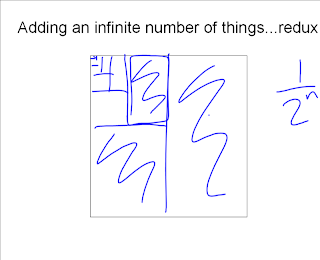I received this message from Alan Stevens, Nottingham Maths Jam attendee. I am putting it here so readers of this blog and the other Maths Jams might consider the topic as well.
Although I won’t be able to make the next MathsJam at Nottingham I’ve thought of a theme you might like to consider. I don’t know if you have themes, but, if you do, how about “Pictorial proofs and derivations”?
Probably the most obvious pictorial proof is of Pythagoras’s theorem (in fact there are probably several such). Do your mathsjammers know of any more?
I thought of this while viewing James Tanton’s YouTube channel, where he has a very pictorial way of looking at maths, including a very nice pictorially based derivation of the geometric series 1/3 + 1/3^2 +1/3^3 + … = 1/2.
If you haven’t seen someone in a t-shirt displaying a pictorial proof of Pythagoras, you haven’t been going to the right sort of conferences! The James Tanton video reminds me of a pictorial demonstration of summing 1/2 + 1/4 + 1/8 + … which I used in a lecture, after Zeno’s paradox of Achilles and the tortoise, when I was trying to get across the idea of an infinite series summing to a finite amount. Shading half a square, then a quarter, then an eighth, and so on it looks like you will eventually shade the whole square and nothing more, a useful illustration that the series converges to one. In fact, I repeated this in the micro-teaching session of my Postgraduate Certificate in Higher Education course and a screenshot of the slide after I drew on it using the interactive whiteboard is below. I’m not sure if this constitutes a proof, though.

On Twitter last night (Maths Jam night) I got replies from @christianp: “I have yet to see a pictorial proof that was more Marcel Marceau than cheeky five-year-old keeping mute” and the Newcastle @MathsJam: “Young diagrams explain integer partitions very well“.
Mathblogging.org picked this “proof with no words” of a theorem by Gomory: http://mathhmagic.blogspot.com/2011/12/gomory.html
For me, it’s very definitely in “cheeky five-year-old” territory – you only really see the cleverness of the proof once it’s been explained in words. Otherwise, you might as well have come up with the proof independently.
I suppose it’s a very good example because unless you send it through Google Translate it’s unlikely you’re able to read the Greek explanation!
In fact, pictorial proofs are everywhere. Here’s one that’s a bit more Marcel Marceau (it’s kinetic! it tells a story!) – http://gaussianos.com/demostracion-sin-palabras-de-la-formula-para-calcular-el-area-de-un-circulo/
Since I was the one suggesting the proof without words for this week’s mathblogging.org picks, let me add that I do think the proof is elegant: it reduces the problem from the plane to the line, which is a typical mathematical strategy but nevertheless a deep one (just like going the other way around).
I also love the one Peter Rowlett posted — it is one of my favorites because it is not a proof, it is much better than a proof! Like shining beacon it visualizes the problem at once, breaks Zeno’s paradox and gives you a perfect picture to hold on to while you formalize a proof.
Here’s a nice list http://mathoverflow.net/questions/8846/proofs-without-words (shameless plug 1: got it from mathblogging.org via our custom search “proof by picture” — there’s more).
Finally, (shameless plug 2) if you don’t mind German, http://vimeo.com/10014698 (I was somewhat involved in this).
This is amazing
I wish if there is anything like geometrifying trigonometry which will prove any kind of trigonometric expression through all possible pictorial forms
Thanks and regards
Sanjoy Nath